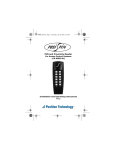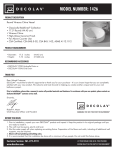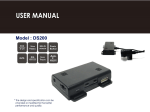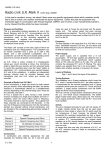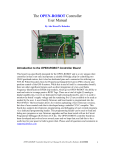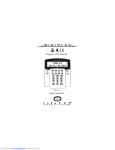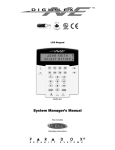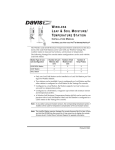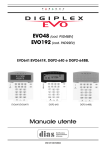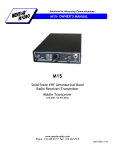Download CR-R885-BL : Reference and Installation Manual
Transcript
PIN and Proximity Reader For Access Control Systems (CR-R885-BL) Installation and Operating Instructions V1.1 We hope this product performs to your complete satisfaction. Should you have any questions or comments, please visit www.paradox.com and send us your comments. TABLE OF CONTENTS Selecting an Installation Site: .......................2 Mounting and Wiring....................................2 Mounting on Metal Surfaces ..........................3 Technical Specifications................................3 Feedback ...................................................5 Programming..............................................6 Card/Code Options ......................................7 Keypad Communication Format.....................7 Transfer Limit for 4-bits Buffered Format ........8 Display on Card Read...................................9 Keypad Lockout ..........................................9 26-bit Wiegand Card Family Code Setting ..... 10 Reader’s Interface ..................................... 10 Check-in Supervision ................................. 11 Buzzer Setting .......................................... 11 Face Light Intensity ................................... 12 Face Light Operation.................................. 12 Face Light Colour ...................................... 12 Changing the Installer Code........................ 13 Panic Alarm .............................................. 13 Resetting to Default................................... 13 Card Presentation Test............................... 14 Warranty ................................................. 15 Proximity Reader 1 INSTALLATION For the reader to function correctly with the access control system, some programming may be required in the controller or control panel of the host system. For further instructions, refer to the appropriate manual. Only explanations directly concerning the reader’s programming will be included in this manual. SELECTING AN INSTALLATION SITE: • Avoid wiring the reader’s cables in the same conduit as AC power cables, lock power or signal wiring. • Reader wiring must remain a minimum of 30cm (12in) away from other wiring, such as wiring for AC power, computer data, telephones, electric locks, etc. • Avoid sites within 1.1m (3.5ft) of computer monitors or CRTs. • Avoid sites near sources of broad spectrum EMI noise, such as motors, pumps, generators, DC to AC converters, AC switching relays, power supplies, and light dimmers. • Avoid sites near potential sources of RF signals, such as cellular phones, two-way radios, etc. MOUNTING AND WIRING After selecting a site for the reader, use the mounting plate as a guide to drill two holes to secure the mounting plate and a hole for the cable 0.95cm to 2.54cm (0.375in to 1in) wide. Place a grommet around the edge of the hole for the cable. Prepare the reader’s cable by cutting the cable 2 Installation Manual jacket back 3.175cm (1.25in) and stripping the wires back 0.635cm (0.25in). Splice the reader’s wires with a recommended cable wire. Route the cable to the controller and connect as shown in Figure 1: Connection Drawing on page 5. MOUNTING ON METAL SURFACES Although the read range may slightly decrease, the reader can be mounted on metal. However, do not box in or surround the card reader with any kind of metal. If the reader must be installed in a metal enclosure, ensure that the face of the card reader is not covered and that at least 1.6" (4cm) remain between the card reader and the metal on all sides of the card reader. TECHNICAL SPECIFICATIONS Input Voltage: Input Current: Consumption: Frequency: Operating Temp: Output formats: Cable Distance: Typical: 13.8Vdc, min.: 11.0Vdc, max: 14.5Vdc Typical: 65mA @ 12.5Vdc, with card: 105mA Typical: 812mW @ 12.5Vdc, with card 1.31mW Exciter Field: 125KHz Pulse Modulated, receive low: 12.500KHz, Receive high: 15.625KHz -25°C (-13°F) to +65°C (+149°F) Reader: 26- and 37-bit Wiegand Keypad: 8-, 26- and 37-bit Wiegand, 4-bit with or without parity, and 4 bits buffered with or without parity 152.4m (500ft.) Proximity Reader 3 Suggested Cables: 22AWG, 0.8mm, Multi-conductor, Alpha 5196, 5198 18AWG, 1.2mm, Multi-conductor, Alpha 5386, 5388 Belden 9553, 18AWG, 6conductor, stranded w/overall shield Indicators: Beeper, red LED, green LED, blue or green Face Light Weight: 280g (9.8 oz.) Material: Black, UV resistant, ABS plastic Dimensions: 99.5mm (5.75in.) x 118.5mm (2in.) x 19.5mm (1in.) Approvals: Compliant to all EU and EFTA countries except Greece according to RTT&E directives. 4 Installation Manual Access Control Figure 1: Connection Drawing FEEDBACK Visual Feedback: When information is entered on the reader’s keypad, the red and/or green LEDs will flash, remain constant or extinguish depending on the operation. Proximity Reader 5 Confirmation Beep: When an operation is successfully entered, the reader emits a rapid series of beep tones (“beep-beep-beep-beep-beep”). Rejection Beep: When the system reverts to a previous status or an operation is incorrectly entered, the reader emits one long beep tone (“beeeeeeeeeep”). PROGRAMMING Ensure that corresponding programming is completed in the control panel or controller connected to the reader. To Program: 1. Press and hold the [CLEAR] key for 4 seconds. The reader emits a confirmation beep and the green LED illuminates. 2. Enter the [INSTALLER CODE]. Press the [ENTER] key. (default:000000) Reader emits a confirmation beep and the green LED flashes. 3. Enter the 3-digit [SECTION]. Press the [ENTER] key. Reader emits a confirmation beep and the green LED stops flashing. 4. Enter the required [DATA]. Press the [ENTER] key. The reader emits a confirmation beep and the green LED flashes. 6 Installation Manual 5. To program another section, repeat steps 3 and 4. To exit programming mode, press and hold the [CLEAR] key for 4 sec. The reader emits a rejection beep and the green LED extinguishes. CARD/CODE OPTIONS Section [001] - Default: [3] The reader can also function as a keypad. Enter Description [0] [1] [2] [3] Keypad and reader disabled. For programming only. Reader only enabled. A user must present a valid card to the reader for Access Granted. Keypad only enabled. A user must enter a valid code on the keypad for Access Granted. Keypad and reader enabled. A user must present a valid card and enter a valid code for Access Granted. KEYPAD COMMUNICATION FORMAT Section [002] - Default: [1] The reader must use the same keypad communication format as the controller. Enter Description [0] [1] [2] 8-bit Wiegand (Motorola ARK). 26-bit Wiegand (also see section [006]). 37-bit Wiegand Proximity Reader 7 [3] [4] [5] [6] 4 bits without parity. 4 bits with parity. 4 bits buffered without parity (also see section [003]). 4 bits buffered with parity (also see section [003]). Note that BCD is not supported. TRANSFER LIMIT FOR 4-BITS BUFFERED FORMAT Section [003] - Default: [00] This feature sets the number of digits retained in memory before the data is sent to the controller. For example, if section [003] is set at 05, the reader will transmit once five digits are entered on the keypad. This feature only applies when the format programmed in Section [002] is set for Option [5]: 4 bits buffered without parity or Option [6]: 4 bits buffered with parity. Enter Description If section [002] is Option [5]: [01] to [11] 4 bits buffered without parity. If section [002] is Option [6]: [01] to [10] 4 bits buffered with parity. 8 Installation Manual DISPLAY ON CARD READ Section [004] - Default: [3] The response from a card being presented to the reader can be adjusted according to the installation’s requirements. Enter [0] [1] [2] [3] [4] [5] [6] [7] Description Display on Card Read disabled Red Status LED flashes* Green Status LED flashes* Red and green Status LEDs flash* Face Light flashes Face Light and red Status LED flash Face Light and green Status LED flash Face Light and both Status LEDs flash Select [0] in Face Light Operation (see page 12) to enable options [0] to [3] in section [004] or select [1] in Face Light Operation, (see page 12) to enable options [4] to [7] in section [004]. * If section [103] (page 12) is set to [1], the face light will also flash. KEYPAD LOCKOUT Section [005] - Default: [0] The reader’s keypad comes with a feature that will lock the keypad for 60 seconds when an installer code is entered incorrectly 3 consecutive times. Proximity Reader 9 Enter [0] [1] Description Keypad Lockout disabled. Keypad Lockout enabled. 26-BIT WIEGAND CARD FAMILY CODE SETTING Section [006] - Default: [000] When the keypad is enabled, the card’s family code must be programmed in order for the keypad to recognize the user’s PIN. When a user enters a PIN on the keypad, the reader will automatically add the family code programmed in section [006] to the beginning of the PIN before transmitting the data to the controller. Therefore, also ensure that all cards to be used with the reader contain the same family code. This feature only applies when the communication format programmed in Section [002] is set for Option [1]: 26-bit Wiegand. Enter [0] to [255] Description Cards’ Family Code. READER’S INTERFACE Section [007] - Default: [0] The reader must be programmed to use the same communication format as the controller. Enter [0] [1] Description 26-bit Wiegand. 37-bit Wiegand. 10 Installation Manual CHECK-IN SUPERVISION Section [008] - Default: [0] This feature only applies when the communication format programmed in Section [002] is set for Option [1]: 26-bit Wiegand or Option [2]: 37-bit Wiegand. When no actions are performed on the reader for a period of time, it will communicate its status to the controller every 30 seconds by sending a code to confirm its presence (26-bit Wiegand = 255:65535; 37-bit Wiegand = 65535:65535). If the reader does not communicate its status every 30 seconds, the controller can be programmed to generate an alarm. Enter [0] [1] Description Check-in Supervision disabled. Check-in Supervision enabled. BUZZER SETTING Section [101] - Default: [3] The number of beep tones emitted as a response to a card being presented to the reader can be adjusted from 0 (disabled) to 7 (7 rapid beep tones). Enter [0] to [7] Description Number of beep tones per response. Proximity Reader 11 FACE LIGHT INTENSITY Section [102] - Default: [4] The Face Light’s illumination can be adjusted according to the installation’s requirements from 0 (extinguished) to 8 (brightest). Enter Description [0] to [8] Face Light’s intensity level. FACE LIGHT OPERATION Section [103] - Default: [0] The Face Light can be set to remain illuminated continually or can follow the Status LEDs’ state. Enter Description [0] [1] Face Light constant. Face Light follows Status LEDs. If [0] in section [103] is selected, this will override options [4] to [7] in Display on Card Read (see page 9). In addition, if [1] in section [103] is selected, this will override [0] to [3] in Display on Card Read (see page 9). FACE LIGHT COLOUR Section [104] - Default: [0] The Face Light’s colour can be blue or green as desired. 12 Installation Manual This feature only applies when Face Light Operation programmed in Section [103] is set for Option [0]: Face Light constant. Enter [0] [1] Description Blue Face Light. Green Face Light. CHANGING THE INSTALLER CODE Section [200] - Default: 000000 The Installer Code is used to enter the reader’s programming mode. The Installer Code is six digits long where each digit can be any value from 0 to 9. PANIC ALARM A panic code can be generated and transmitted to the controller by pressing and holding the [CLEAR] and [ENTER] keys for 2 seconds (26-bit Wiegand = 255:65534; 37-bit Wiegand = 65535:65534). This feature only applies when the communication format programmed in Section [002] is set for Option [1]: 26-bit Wiegand or Option [2]: 37-bit Wiegand. RESETTING TO DEFAULT To reset the reader to factory defaults, disconnect its power supply. Press and hold the [1] and [2] keys simultaneously while reconnecting its power supply. Proximity Reader 13 CARD PRESENTATION TEST Present the card to the reader as shown in the figure below. Place the card parallel to the reader and move it toward the reader until the card code displays on the controller screen. At this point, the card is read, decoded, data transmitted to the controller and the controller has responded accordingly. To read the card again, remove and reinsert the card into the reader's field. 14 Installation Manual WARRANTY For complete warranty information on this product please refer to the Limited Warranty Statement found on the website www.paradox.com/ terms. Your use of the Paradox product signifies your acceptance of all warranty terms and conditions. © 2003-2007 Paradox Security Systems Ltd. All rights reserved. Specifications may change without prior notice. One or more of the following US patents may apply: 7046142, 6215399, 6111256, 6104319, 5920259, 5886632, 5721542, 5287111, 5119069, 5077549 and RE39406 and other pending patents may apply. Canadian and international patents may also apply. The PIN and Proximity Reader is a trademark or registered trademark of Paradox Security Systems Ltd. or its affiliates in Canada, the United States and/or other countries. Proximity Reader 15 Notes 16 Installation Manual For technical support in Canada or the U.S., call 1-800-791-1919, Monday to Friday from 8:00 a.m. to 8:00 p.m. EST. For technical support outside Canada and the U.S., call 00-1-450-491-7444, Monday to Friday from 8:00 a.m. to 8:00 p.m. EST. Please feel free to visit our website at www.paradox.com. paradox.com Printed in Canada 11/2007 PPIN-EI02




















